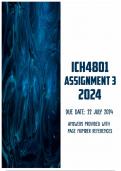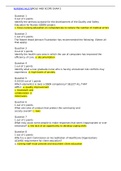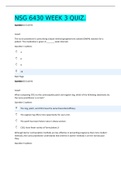, PLEASE USE THIS DOCUMENT AS A GUIDE TO ANSWER YOUR ASSIGNMENT
Please note that the author of this document will not responsibility for any plagiarizing you
commit.
Question 1
1A) Comparative education (chapter 8 of the prescribed book)
1.1. Define “comparative education”.
Comparative education is an academic field that involves the study and analysis of different
education systems, practices, and policies across various countries and regions. It encompasses a
three-in-one perspective on education, as outlined by Wolhuter (2015), which includes an education
system perspective, a contextual perspective, and a comparative perspective.
Education System Perspective: This aspect of comparative education focuses on the structure,
organization, and functioning of education systems within specific countries or regions. It
involves examining the curriculum, pedagogical methods, assessment practices, and
educational governance within a particular system.
Contextual Perspective: The contextual perspective of comparative education emphasizes the
societal, cultural, economic, political, and demographic factors that influence and shape
educational experiences within a given context. It explores the multifaceted relationships
between societal contexts and educational outcomes, including issues related to social mobility,
social status, and the impact of societal forces on education.
Comparative Perspective: Comparative education involves the comparative analysis of
different education systems or aspects of systems across diverse societal contexts. It seeks to
identify similarities, differences, and trends in educational practices, policies, and outcomes,
with the aim of understanding the global dynamics of education and the interplay between local,
national, and global forces.
In recent years, there has been a growing emphasis on the global study of education, leading to the
proposal to change the name of the field to "comparative and international education" (CIE). This
shift reflects the evolving nature of the field and its focus on understanding the dynamic interplay of
global, national, and local forces that shape education systems and outcomes. Comparative education
also encompasses the study of the international education project, which involves examining
education from a global perspective and understanding the impact of broader global forces on
education systems.
(Page 146-147)
, 1.2. Discuss any four phases of the historical evolution of the field of comparative and
international education.
The historical evolution of the field of comparative and international education has undergone
several phases, reflecting changes in scholarly focus, research methodologies, and the global context.
Four key phases in the historical evolution of the field can be identified:
Early Development and Foundational Phase: This phase dates back to the late 19th and
early 20th centuries when the field of comparative education began to take shape. Scholars and
educators started to compare educational systems across different countries, aiming to
understand the impact of cultural, social, and economic factors on education. This phase laid
the groundwork for the systematic study of education from a comparative perspective.
Post-World War II Expansion and Globalization: The post-World War II era marked a
significant expansion of comparative and international education. The establishment of
international organizations such as UNESCO and the World Bank led to increased interest in
global education issues. This phase saw a growing emphasis on international cooperation,
educational development, and the exchange of educational practices and policies across
nations.
Critical and Interdisciplinary Turn: In the late 20th and early 21st centuries, the field of
comparative and international education experienced a critical turn, marked by a shift towards
interdisciplinary approaches and critical perspectives. Scholars began to critically examine the
impact of globalization, neoliberal policies, and cultural imperialism on education systems
worldwide. This phase also involved a focus on social justice, equity, and the role of education
in addressing global challenges.
Contemporary Globalization and Digital Era: The contemporary phase of comparative and
international education is characterized by the increasing impact of globalization, digital
technologies, and transnational educational trends. This phase involves a focus on the
digitalization of education, global learning networks, and the implications of technological
advancements on educational practices. It also encompasses the study of global citizenship
education, sustainable development goals, and the role of education in addressing complex
global issues.
Each of these phases has contributed to the evolution of comparative and international education as a
dynamic and interdisciplinary field, reflecting changes in the global landscape and the ongoing quest
to understand and improve education systems across the world.
(Page 17)







